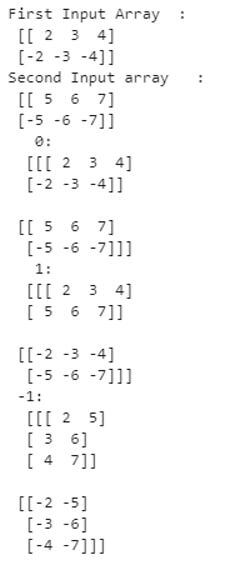

''' NPE's Answer Modified A Bit For My Case '''
#XSORT NUMPY CODE#
off99555's answer was the most elegant, but it is the slowest.Ĭomplete Code for Test and Comparisons import numpy as np.I went with this answer, because even though it took more work, it was not too bad and had significant speed advantages. Fred Foos answer required the most refactoring for my needs but was the fastest.NPE's answer was the next most elegant and adequately fast for my needs.

I then compared the speed of each method. Speed was important for my needs, so I tested three answers to this question.Ĭode from those three answers was modified as needed for my specific case. Here we discuss how Numpy.argsort() work along with the respective examples and parameters.Three Answers Compared For Coding Ease And Speed Therefore, in a way reduces the verbosity of the code increases the speed of computation especially when the data set which are being processed are very large and may be of a large dimension. It saves time and complexity for other viewers who would be externally use it. The argsort provides for an exclusive function which is a very essential and frequently used functionality for most data intensive code work. Print('Using a loop for reconstruction of our array:') Print('Sorting our array in ascending order:') Print('Using the argsort() function to the array:') Output after using arg * sort () on 2 * – * D array: In the output we can see an nd_array has been visualized which is shown to be containing the indices that indicate the actual sequential position of each of the element of the array that has been sort along with the dtype. * array() which contains the integer values of 564, 11 and 321 whose values are then sorted using the function. Let us take some examples to understand n1.argsort() on various dimensionally oriented arrays to understanding the mechanism of sorting used:Īn array ‘num’ as been created using the function n1 *. Sorting the Algorithms for NumPyįollowing are the properties of the three variables with respect to the arguments for argsort(): Kind of argument The argsort function is utilized to return and the indices representative of the array where the array ‘a’ is sorted along the axis which has been specified by the user. Returned argument on execution of the argsort() function: index_array:(ndarray, int) But in such cases, the unspecified fields present would still be used by the function which are used by the d | type and aid in breaking the ties in order related functionalities As all fields do not have be necessarily specified, a single field itself is specified in form of a string. Order: str (string) or*list of str (this parameter is optional)įor an array ‘a’ which has defined fields, the order argument plays the role of defining which field has to be compared first and so on. The time sort is used by both stable I and mergesort on the background, but the difference and variety of the data types used of the input array defines their implementation.
/userfiles/images/numpy-5.jpg)
The default parameter for kind is set to “quick sort” unless the user defines another kind. It is used to define the algorithm to be sorted. If the axis is set as None, the array which is flattened is processed for performing the sort. When nothing is specified for the axis parameter, the default axis taken to be -1. The parameter ‘axis’ is used to define the axis alongside which the arranging has to be performed. The parameter ‘a’ is used to define the array that the user wants to be sortedĪxis: int (integer) or None (not defined) (this parameter is optional) These are the parameters used in numpy.argsort() have been listed below: Parameters for Argsort


 0 kommentar(er)
0 kommentar(er)
